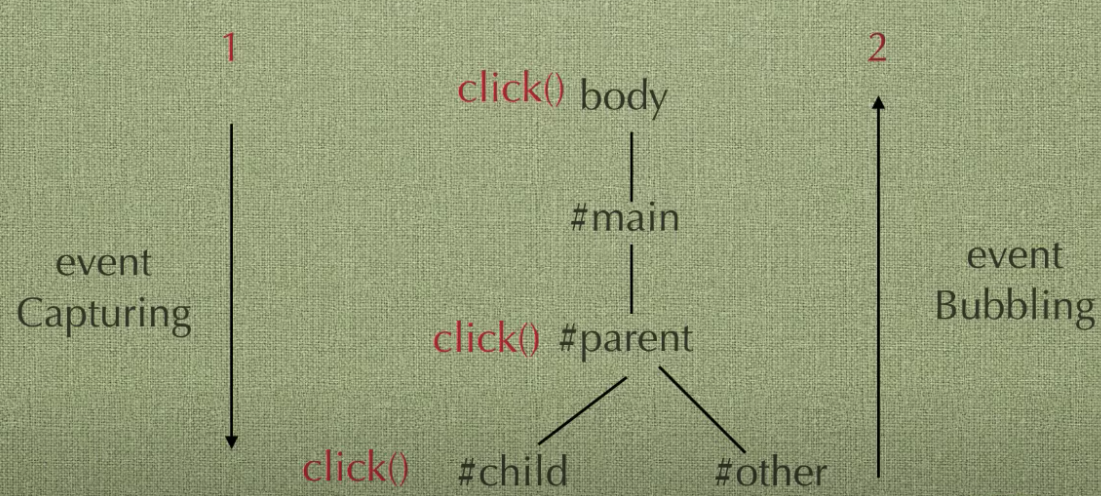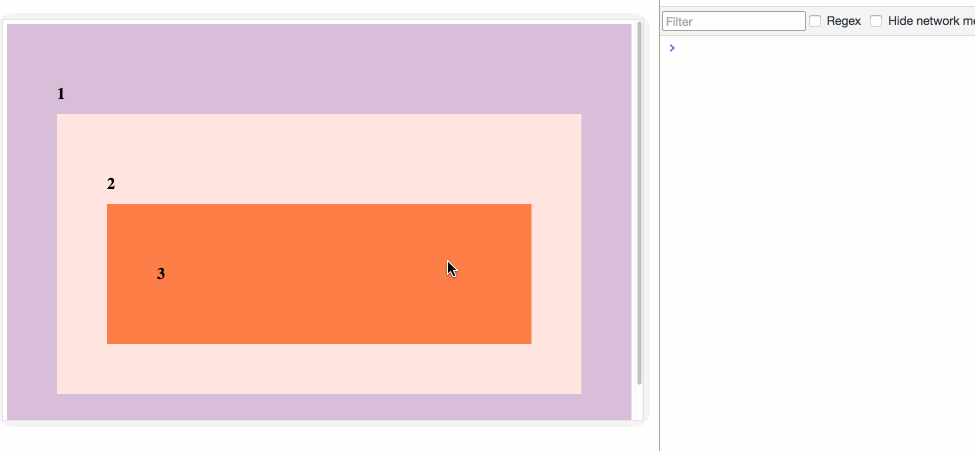JSConcepts
What is Event Delegation
Event Delegation is a technique involving attaching event listeners to the parent instead of attaching to a child. It leverages the power of event-bubble-up mechanism.
There are some of the common JavaScript events:
- change:: An HTML element has been changed
- click:: The user clicks an HTML element
- mouseover:: The user moves the mouse over an HTML element
- mouseout:: The user moves the mouse away from an HTML element
- keydown:: The user pushes a keyboard key
- load:: The browser has finished loading the page
Event Capturing vs Event Bubbling (Event Propagation)
Whenever a user clicks on a div, Event Capturing happens first, and then Event Bubbling

<html>
<head></head>
<body>
<h1> Event Bubbling Example</h1>
<div id="Box">
<div id="mid">
<button id="myButton">Click Me!</button>
</div>
</div>
</body>
</html>;
var parent = document.getElementById("Box");
parent.addEventListener(
"click",
function () {
console.log("Box is clicked");
},
true // event capturing = true
);
var mid = document.getElementById("mid");
mid.addEventListener(
"click",
function () {
console.log("mid is clicked");
},
true // event capturing = true
);
var child = document.getElementById("myButton");
child.addEventListener(
"click",
function () {
console.log("Button is clicked");
},
true // event capturing = true
);
/* So in this case, the console prints:
Box is clicked
mid is clicked
Button is clicked
*/
In the phase of Event Bubbling, a click event ripples up all the way up to the top of the DOM and triggers clicks events on all the parent elements of the element you clicked

<html>
<head></head>
<body>
<h1> Event Bubbling Example</h1>
<div id="Box">
<div id="mid">
<button id="myButton">Click Me!</button>
</div>
</div>
</body>
</html>;
var parent = document.getElementById("Box");
parent.addEventListener("click", function () {
console.log("Box is clicked");
});
var mid = document.getElementById("mid");
mid.addEventListener("click", function () {
console.log("mid is clicked");
});
var child = document.getElementById("myButton");
child.addEventListener("click", function () {
console.log("Button is clicked");
});
/* Since the 3rd argument is unset, the console prints:
Button is clicked
mid is clicked
Box is clicked
*/
And here is how the click event bubbling up

So how to add event listener(s) to the buttons
<table id="test">
<tr>
<td>List item1</td>
<td><input type="button" value="edit" data-index="1" /></td>
</tr>
<tr>
<td>List item2</td>
<td><input type="button" value="edit" data-index="2" /></td>
</tr>
<tr>
<td>List item3</td>
<td><input type="button" value="edit" data-index="3" /></td>
</tr>
<tr>
<td>List item4</td>
<td><input type="button" value="edit" data-index="4" /></td>
</tr>
<tr>
<td>List item5</td>
<td><input type="button" value="edit" data-index="5" /></td>
</tr>
<tr>
<td>List item6</td>
<td><input type="button" value="edit" data-index="6" /></td>
</tr>
<tr>
<td>List item7</td>
<td><input type="button" value="edit" data-index="7" /></td>
</tr>
</table>
<script type="text/javascript" src="//code.jquery.com/jquery-1.9.1.js"></script>
<script>
$("#test [type=button]").on("click", function () {
alert("hi, edit is fired on row " + $(this).data("index"));
});
</script>
Reference
https://medium.com/@bretdoucette/part-4-what-is-event-delegation-in-javascript-f5c8c0de2983